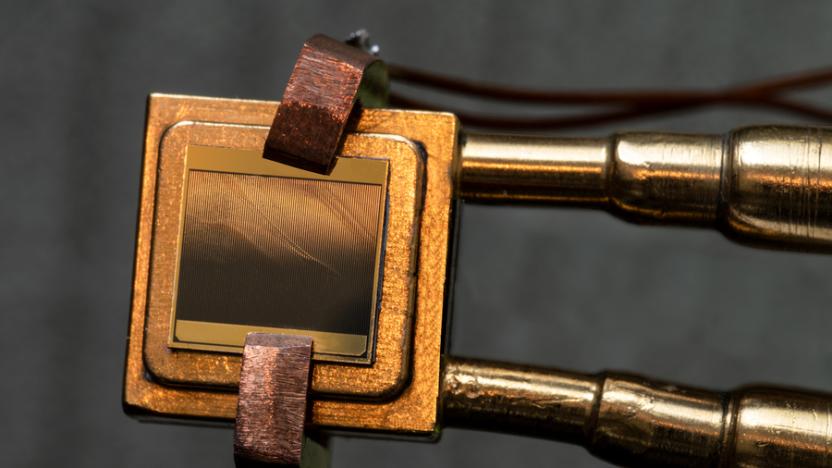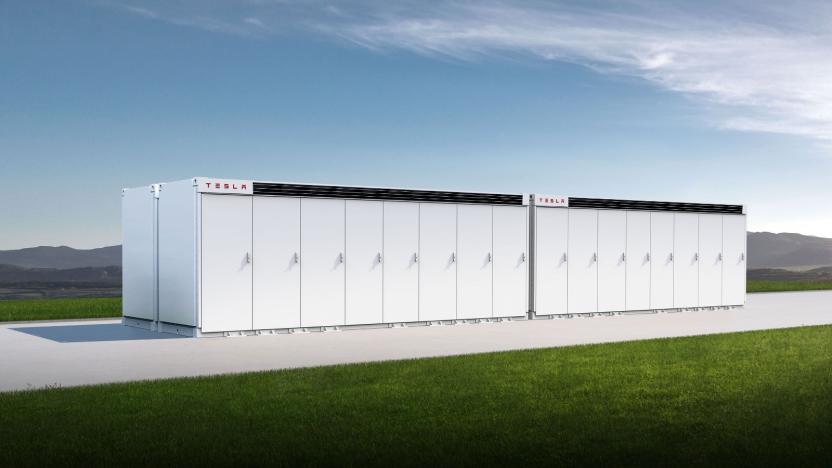energy storage
Latest

Thermophotovoltaic cell converts 40 percent of heat energy to electricity
Researchers have revealed a new thermophotovoltaic (TPV) cell that can convert heat to electricity with over 40 percent efficiency.

Tesla is building a 100MW energy storage project in Texas
In Angleton, a town of nearly 20,000 located 40 miles south of Houston, Tesla subsidiary Gambit Energy Storage is installing the company’s modular Megapacks.

Tesla's Megapack is a battery built for the electrical grid
Tesla's utility-sized energy storage has become a practical reality. The tech company has introduced the Megapack, a container-sized battery meant for "large-scale" storage that could help quickly deploy renewable energy and even replace conventional "peaker" power plants that come online when there's high demand. A single Megapack has up to 3MWh of storage, or roughly 14 times the 210kWh of a Powerpack. That, in turn, leads to very rapid deployments. Tesla claimed it could deploy a clean 250MW, 1GWh power plant in less than three months, or four times faster than a similarly-sized fossil fuel plant.

Rivian will repurpose used EV batteries for solar power in Puerto Rico
Rivian is known for pushing the boundaries of battery tech. Not only is the startup working on the first all-electric pickup for the US market, it's also planning "Rivian-to-Rivian" charging, which will allow its vehicles to charge each other, and it designed a camp stove add-on that takes advantage of the EV's battery pack. Now, the company wants to turn its used batteries into an energy storage system for a solar power microgrid in Puerto Rico.

Researchers want to store excess renewable energy as methane
One of the major drawbacks to renewable energy sources like wind and solar is that we don't have an effective way to store excess energy. When the wind blows, we might have more than enough energy to feed the grid, but we can't store the surplus. Then, on breezeless days, we're left powerless. As trite as that might sound, it's unfortunately valid, and companies like Tesla have been trying to develop large battery storage solutions. Now, researchers at Stanford University are working on a biology-based battery alternative.

New 'semi-solid' battery could recharge EVs as fast as pumping gas
Researchers at MIT reckon they've struck oil. In fact, you're looking at what they call "Cambridge crude" -- a substance that could halve the weight and cost of EV batteries and make them quicker to charge too. The black goo is packed with a high concentration of energy in the form of particles suspended in a liquid electrolyte. When separated by a filter, these particles function as mobile electrodes that can be pumped into and around a system before the energy is released. So instead of waiting up to 20 hours to juice your Nissan Leaf, you could potentially just pump this pre-charged substance into it -- rather like dirty old gas. Until now, no such "semi-solid flow cell" has been able to hold useful quantities of energy, but this stuff literally oozes with it. Not only could it power EVs, it could even be used for large-scale electricity storage for utilities. The researchers insist this energy revolution is years off -- but when it comes, there will be blood.

Beacon Power completing construction of 20-megawatt flywheel plant, the world's largest
Remember Beacon Power, that startup using 2,800-pound flywheels to cut noxious emissions? Well, three years later, the company is wrapping up construction of its first plant, a 20-megawatt operation that just happens to be the world's largest. The Stephentown, NY facility is home to 200 of these flywheels, which store and output energy as needed, essentially matching the power supply with the demands of the grid. The result, the company promises, is reduced energy waste and stable electrical frequencies hovering around 60Hz. And while the plant's already up and running at 18 megawatts, it won't be until later this month that Beacon finishes building it out so that it reaches its full capacity. Full PR and champagne-popping celebration plans after the break. %Gallery-125247%

Toyota working on magnesium batteries for PHEVs of the not so near future
Toyota wants to take your range anxiety out for a walk behind the woodshed and obliterate it from the known world. The means for doing this, the Japanese giant has revealed, might very well be contained in its new magnesium-sulfur batteries, which promise to double the energy density of the current industry-best lithium ion cells. Of course, the catch here is that the new magnesium goodness is nowhere near ready and is projected to come in 2020 at the earliest, but we're gladdened to see a long-term view being taken by car manufacturers with regard to powering vehicles electrically. Alternative methodologies currently under review in Toyota's labs also include aluminum and calcium materials, showing that there is indeed no lack of ambition for making plug-ins respectable road warriors.

Graphene electrodes promise 5x energy storage boost for ultracapacitors
Graphene. We hear of your achievements so often, but feel your benefits in our everyday lives so infrequently. We'd be remiss if we didn't point out how unhealthy of a relationship this is, but hopefully Bor Jang and co. have a mind to mend it all. Bor, along with a number of colleagues at Nanotek Instruments, have just uncovered a graphene advancement that could put conventional Li-ion cells in a world of hurt. Of course, we've been hearing about so-called "battery breakthroughs" for the better part of our lives, but few have involved progress with ultracapacitors. For those unaware, ultracapacitors are energy storage devices that can "absorb and release charge in minutes," and they're pegged as cheaper / safer alternatives to batteries for electric vehicles. The only problem? Mainstream versions today hold just five percent of the energy held by Li-ion batteries. Nanotek's crew has figured out that the use of graphene electrodes "could lead to ultracapacitors with more than five times the energy density of commercial devices," but as these things always go, no one's coming close to producing a hard release date. We'll just assume it's undergoing lab tests for now, and in 2022 we can all weep at what could've been. Prove us wrong, whiz kids.

UTexas researchers develop organic battery, aim for week-long use in smartphones
Christopher Bielawski, a brilliant mind working at the University of Texas at Austin, had this to say about his newest discovery: "I would love it if my iPhone was thinner and lighter, and the battery lasted a month or even a week instead of a day; with an organic battery, it may be possible." Anyone that has ever owned an iPhone (or a smartphone or any sort, really) can grok just how bold those words are, but according to Mr. Bielawski, "we're now starting to get a handle on the fundamental chemistry needed to make this dream a commercial reality." At the center of this potential revolution is a newfangled organic battery recently detailed in the journal Science, but just as important is the artificial photosynthesis that the research also touches on. Bielawski and colleague Jonathan Sessler have seemingly figured out how to create an electron transfer process that can proceed in the opposite direction, with this forward and backward switching of electron flow opening up new avenues for the historically stagnant battery innovation market. Granted, these guys have yet to demonstrate that the process can occur in a condensed phase, so actual commercialization is probably a century millennium or two out, but hey -- at least our list of "awesome thing that'll probably never happen" has grown by one.

Carbon nanotubes find yet another purpose, could star in ultra-reliable batteries
Carbon nanotubes are kind of like peanuts. They both seem pretty simple at first glance, but with a little work, you can make pretty much anything out of 'em. Take this case, for example, as MIT boffins have discovered that by forming the tube-shaped molecules of pure carbon into minuscule springs, they could be "capable of storing as much energy, pound for pound, as lithium-ion batteries." The real kicker is exactly how they'd do it -- "more durably and reliably." Essentially, these newfangled cells could be left alone for years on end without losing their charge, and unlike conventional batteries, these wouldn't suffer from performance degradation when exposed to temperature extremes. Of course, anything as pie-in-the-sky as this is probably at least a decade or so out from Walmart shelves, but considering that the group responsible has already filed a patent, we'd say they're pretty confident in the possibilities.[Via Physorg]

Altair Nanotechnologies, AES collaborate on energy storage products
After sinking $3 million into a company, what better to do than utilize the synergies and compliments between the two and crank out new products to better our lives? AES is apparently digging said mantra and looking to profit on its strategic investment in Altair Nanotechnologies by announcing a "joint development and equipment purchase agreement." Essentially, the two will reportedly work together to jointly "develop a suite of energy storage solutions," some of which are expected to deliver over 1MW of power and 500KWh of energy. Unsurprisingly, Altairnano is supposedly working with AES to apply these products and systems at "strategic points within the electrical grid to more efficiently deal with congestion, peak energy consumption, and real-time fluctuations in electricity demand." Interestingly, little is being said thus far about the actual design of the unit, but a prototype is slated to be completed by the year's end.[Via CNET]






